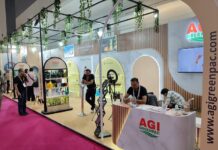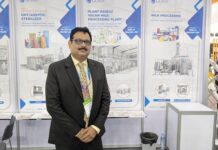New Delhi, India, 1 June 2021, Tetra Pak is showcasing its new UHT 2.0 heating portfolio and Tetra Pak E3/Speed Hyper packaging equipment on World Milk Day. It is to highlight this year’s theme of sustainability and the dairy industry’s commitment to innovation in reducing its environmental footprint.

The new UHT 2.0 portfolio with OneStep technology and Tetra Pak’s E3/Speed Hyper reduce water and steam consumption, creating less wastewater and thereby lowering the cost of its removal for dairy manufacturers. Adding a water filtering station unit to the Tetra Pak E3/Speed Hyper helps recover 5,500 liters of water per filling machine running hour (up to 95%), while contributing to lower water consumption.
With water scarcity on the rise, wastewater is increasingly becoming a pressing industry concern. Up to a fifth of Tetra Pak’s customers are based in high or extremely high-risk water areas and the company is prioritising action to address this.
The combination of UHT 2.0 with OneStep technology and Tetra Pak E3/Speed Hyper scores well across industry benchmarks for sustainability, with a 0.8 GHG Index score, a 0.3 Water Index score and a Product Losses Index score of 0.71. When compared to a conventional line solution2 this optimal integrated solution reduces GHG emissions by 20%, water usage by 70% and product losses by 30%.

Alejandro Cabal, vice president Packaging Solutions, Tetra Pak, said, “As part of Tetra Pak’s wider ambition to reach net zero emissions across the value chain by 2050, we want to be part of the solution to limit climate change for the global dairy sector. To achieve this, accelerating the development of our low carbon circular packaging and equipment portfolio and working to help customers realise their emission reduction targets is a priority. A significant share of emissions comes from the operation of equipment at customers’ sites. Addressing this through innovation and collaboration is vital.”
Upgrades to Tetra Pak’s UHT 2.0 portfolio will enhance automation possibilities and performance, with the offering claimed to represent the strongest5 in the industry. The new UHT 2.0 portfolio combined with OneStep technology cuts processing steps out of the production line without affecting end-product quality.
Tetra Pak E3/Speed Hyper is the world’s fastest aseptic carton filling machine, producing up to 40,000 portion packs per hour, using eBeam6 sterilisation technology to complete the task more efficiently and more rapidly than has previously been possible. This reduces the environmental impact and makes water recycling easier. It couples low-cost high-speed production with significant environmental advantages. While its increased capacity can reduce manufacturers’ operational costs by up to 10%7, it also represents a low carbon alternative to aseptic PET equipment – since electricity consumption and carbon footprint are both five times lower than for aseptic PET lines8.
The announcement follows Tetra Pak’s 2020 pledge to not only reach net zero emissions in its own operations by 2030, but to also realise a net zero emissions ambition across the value chain by 2050. The company has planned a step-change in investment levels in sustainable innovation, committing at least €100 million annually over the next 5-10 years. This will help the company realise its goal of offering processing and packaging solutions with a minimal carbon footprint.
- The combination of UHT 2.0’s OneStep technology with Tetra Pak E3/Speed Hyper has a 0.8 GHG Index score, a 0.3 Water Index score and a Product Losses Index score of 0.7. A GHG Index is the ratio of the CO2 equivalent on the energy consumption of UHT 2.0’s heating with OneStep technology processing and packaging line with the CO2 equivalent on the energy consumption of a conventional indirect heating line.
The UHT2.0 heating line consists of processing equipment including raw milk storage tank, Tetra Pak Indirect UHT unit D, Homogeniser, Deaerator, Separator Hot Milk, Cream Cooler, Aseptic Tank VD and packaging equipment such as Tetra Pak E3 Speed Hyper with capacity of 40.000 packs/h connected with Tetra Pak Water Filtering Station unit and downstream equipment for producing TBA 200 Slim Leaf. The conventional indirect heating line includes an additional Tetra Pak® Pasteurizer D to UHT 2.0 heating processing lines and Tetra Pak A3 Speed with capacity of 24.000 packs/h without Tetra Pak Water Filtering Station.
The energy consumption is referring to electricity, heating and cooling energy for producing unit of UTH milk of the defined processing and packaging lines. World average of GHG emission factor is applied. This calculation is done by using Tetra Pak Processing Solution and Equipment Global TCO (Total Cost of Ownership) tool, Version 1.3. In the similar way, Water and Product Losses Indexes are calculated. - Benchmark is based on a conventional indirect heating UHT milk processing line with a packaging line that doesn’t use eBeam technology.
- Applying a Tetra Pak Water Filtering Station removes lubrication, residues from packaging material, hydrogen peroxide (if using a conventional packaging line) and cleans water before circulating it back into the system. The result on water efficiency is reductions in water usage by up to 95%, which reduces the water index of the optimal solution by more than half (from 0.6 to 0.3).
- Verification and assurance are essential. To that end, Tetra Pak’s practices, processes and performance are verified externally to World-Class Manufacturing standards, ISO 9001, ISO 14001, OHSAS 18001, and Forest Stewardship Council Chain of Custody and Quality Assurance Management certification. The company’s greenhouse gas emissions data is externally audited.
- According to Tetra Pak, benchmarking exercises completed for customer projects have demonstrated that Tetra Pak can deliver the best overall performance.
- eBeam is a technology that has been developed by Tetra Pak in collaboration with its partner COMET. The eBeam technology sterilises packaging material using electron beams and replaces the traditional hydrogen peroxide sterilisation process for packaging material while guaranteeing the same sterilisation performance.
- Compared to Tetra Pak A3/Speed filling machine.
- Compared to aseptic PET lines using hydrogen peroxide sterilisation.
IndiFoodBev — authentic, impactful and influential
An English-language food and beverage processing and packaging industry B2B platform in print and web, IndiFoodBev is in its third year of publication. It is said that the Indian food and beverage industries represent approximately US$ 900 billion in revenues which implies more than 20% of the country’s GDP. Eliminating the wastage on the farmside can help to deliver more protein to a higher number of the population apart from generating sizable exports. The savings in soil, seeds, water, fertilizer, energy and ultimately food and nutrition could be the most immense contribution that country is poised to make to the moderation of climate change.
To improve your marketing and grow sales to the food and beverage processing and packaging industry, talk to us. Our research and consulting company IppStar [www.ippstar.org] can assess your potential and addressable markets in light of the competition. We can discuss marketing, communication, and sales strategies for market entry and growth.
Suppliers and service providers with a strategy and budget for targeted marketing can discuss using our hybrid print, web, video, and social media channels to create brand recognition linked to market relevance. Our technical writers are ready to meet you and your customers for content.
The second largest producer of fruit and vegetables in the world is continuously expanding processing capacities and delivery systems with appropriate innovative technologies. We cover product and consumer trends, nutrition, processing, research, equipment and packaging from farm to thali. Get our 2025 media kit and recalibrate your role in this dynamic market. Enhance your visibility and relevance to existing markets and turn potential customers into conversations. Ask for a sample copy of our bi-monthly in print or our weekly IndiFoodBev eZine each Wednesday.
For editorial info@ippgroup.in — for advertisement ads1@ippgroup.in and for subscriptions subscription@ippgroup.in
Naresh Khanna – 10 February 2025
Subscribe Now











